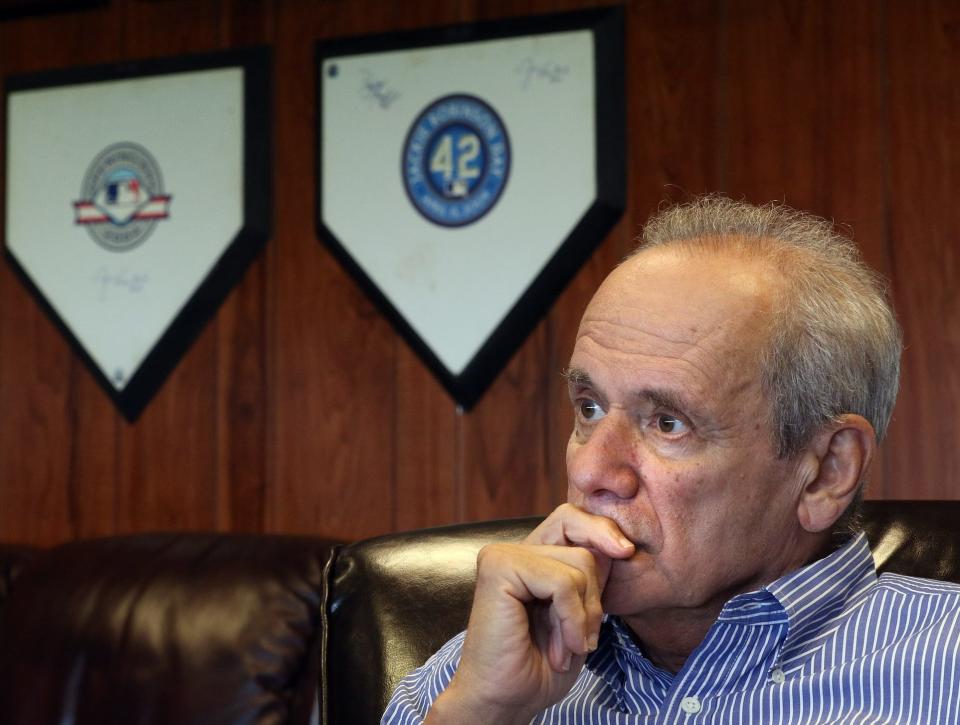Despite his hard edges, late Larry Lucchino helped push the Red Sox to championship level
In terms of the modern Red Sox, Larry Lucchino could be classified as the chief executive of architectural design.
He was the common thread between the club and two of its most influential figures in the 21st century — Theo Epstein and Janet Marie Smith. They were the builders of a curse-breaking roster and a more modernized ballpark experience, respectively.
Lucchino’s legacy in Boston must start in those two spaces. He helped assemble the intellectual talent that ended an 86-year wait for a World Series championship, one that finally came in 2004. He also brought in the visionary that reshaped one of the city’s most historic structures, a renovation that gave us Monster Seats and nearly $2 billion in pledged surrounding improvements.
More: Here's your Red Sox primer as Boston opens its season Thursday night in Seattle

Lucchino died Tuesday at the age of 78, his unique role in the region’s sporting landscape now vacant after a third battle with cancer. He was your sandpapery sibling, your irascible uncle, your boss who called unexpectedly at 10 a.m. on a summer Saturday morning. And in business, despite those occasionally complicated interactions, you tended to be far better with him than without him.
Lucchino’s personality reflected what you might expect from someone raised in a blue-collar steel city like Pittsburgh. Red Sox principal owner John Henry noted in a club statement Lucchino “battled hard” and “found genuine joy in sparring with people.” His willingness to stir the pot and keep peers uncomfortable for the sake of growth was a net positive during a 14-year tenure in Boston.
Epstein was a former intern with the Baltimore Orioles and director of player development with the San Diego Padres who followed Lucchino — an executive at both of those stops — to Boston. His ascension to Red Sox general manager as a 28-year-old was unprecedented, and Epstein repaid that faith with brilliance. Boston made the bold signings and shrewd trades necessary to sweep the Anaheim Angels, rally past the New York Yankees and ground the St. Louis Cardinals, clinching their long-awaited place in immortality.
Smith had worked with Lucchino on the construction of Camden Yards and Petco Park, a throwback gem to the sport’s past and a downtown landmark adjacent to the vibrant Gaslamp Quarter, respectively. She saw past the obstructed views, cramped spaces and surrounding streets that seemed to lock Fenway Park in a forgotten era. What followed was an 820-game sellout streak, a renewed sense of historic pride and a host of attendance records set in the Back Bay.
Lucchino’s contributions off the field included a further strengthening of the relationship between the Red Sox and The Jimmy Fund, the charitable arm of the Dana-Farber Cancer Institute. He helped introduce the annual WEEI/NESN Jimmy Fund Radio Telethon and expanded spring training trips for patients, their families and some of the same medical personnel who helped treat him for non-Hodgkin's lymphoma, prostate cancer and kidney cancer.
Lucchino wasn’t without his professional faults. He was at the center of the misguided negotiation process that ultimately cost the club left-handed pitcher Jon Lester, presenting a substandard initial offer that soured contract extension talks beyond repair. The constant tension his operational tactics created helped lead to Epstein’s brief resignation from the club in October 2005 and infamous clandestine departure from team offices in a gorilla suit.
But the core of Lucchino’s philosophy — the urgency to win at all costs, the venom directed at the Yankees while dubbing them "The Evil Empire," the unquenchable thirst for advancement both on the field and in the public conscience — is lacking in the Red Sox front office today. Dave Dombrowski was the last real vestige of that old guard thinking, and he was dismissed in September 2019. Chaim Bloom dithered his way through four years as chief baseball officer. Current executive Sam Kennedy feels like one of the last people who would push Henry and club chairman Tom Werner beyond their financial and creative limits.
Rhode Island was bruised by Lucchino’s sharp elbows when he helped lead a consortium to purchase the Pawtucket Red Sox in 2015. The club made it a priority to move on from an aging McCoy Stadium and offered a pair of solutions — a downtown ballpark in Providence or a riverside replacement within Pawtucket city limits. General Assembly leader Nicholas Mattiello ultimately prioritized his own political future over making a deal. Lucchino then found a willing suitor in Worcester to both build a new ballpark and use the franchise as a driver for changing the city’s civic footprint.
It was the last major project of Lucchino’s career, and it encompassed all aspects of his professional portfolio. Breaking ground in a new home? A hard decision that cast him as something of a villain? The conviction to push toward success, private and public skepticism be damned?
Not everyone can see the forest through the trees. Lucchino, more often than not, could.
bkoch@providencejournal.com
On X: @BillKoch25
This article originally appeared on The Providence Journal: Larry Lucchino pushed the Red Sox and Fenway Park to the next level

